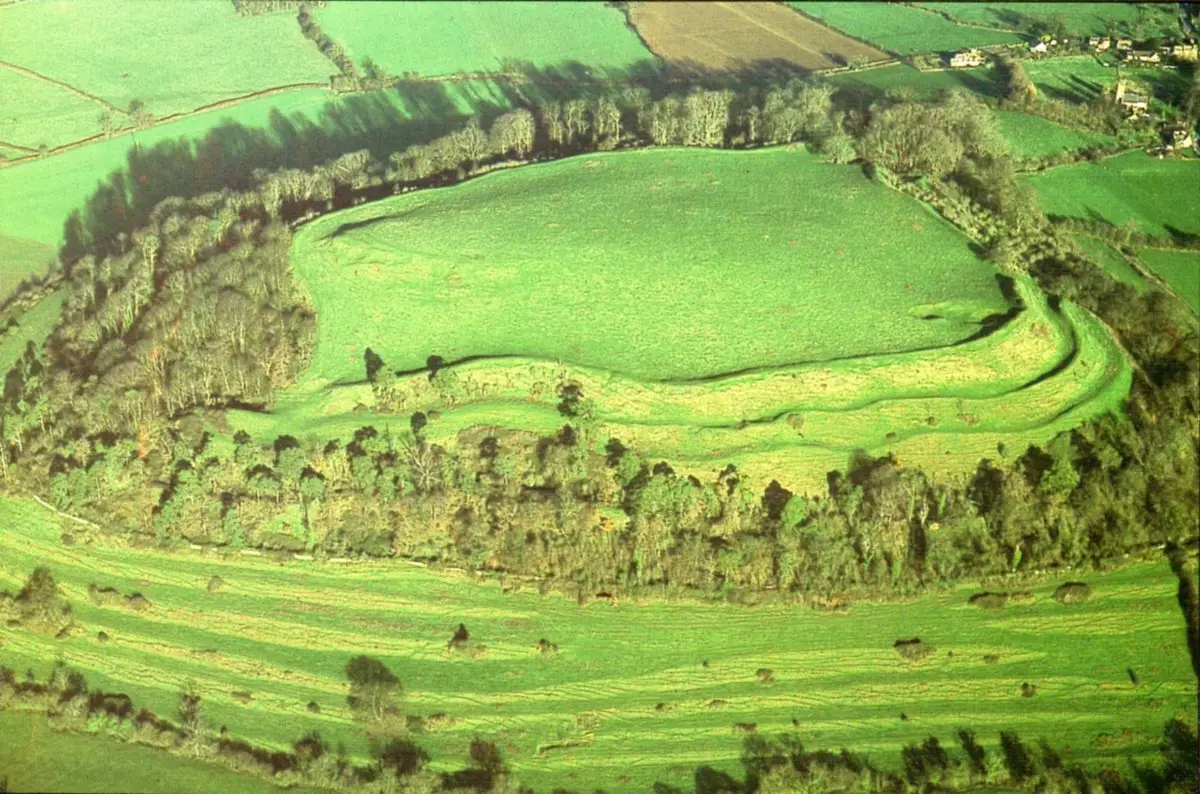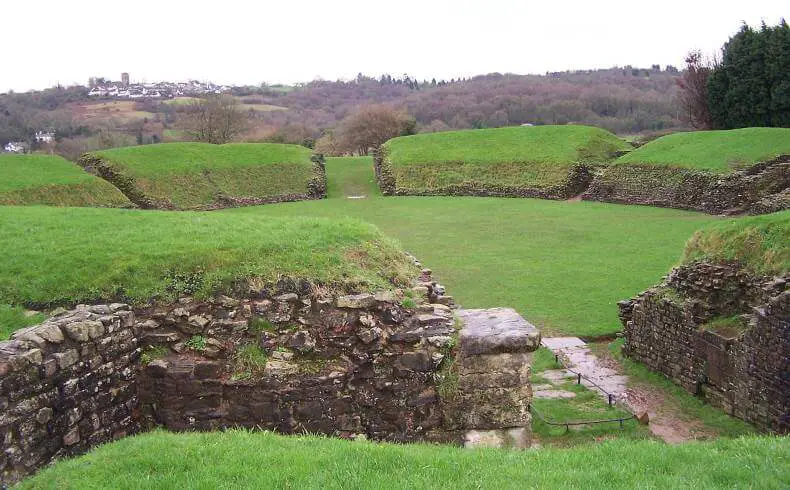There is no location more firmly associated with King Arthur in popular media today than Camelot. This was his famous capital city, usually depicted as a grand castle or walled settlement. But surprisingly, for a place that is so intimately connected with Arthur, scholars regularly state that it never existed at all. What is the basis for such a claim?
The Case Against its Existence
Put simply, the primary reason for stating that Camelot was fictional is that it does not appear in the earliest Arthurian sources, nor does it unambiguously appear in any source prior to the 12th century. The first writer to clearly mention it was Chretien de Troyes, who mentioned it in one line in Lancelot, the Knight of the Cart. From there, it featured more and more prominently among the Arthurian romances, until it finally reached the fame that it now has in Arthurian lore today.
It is argued that this proves that the city never really existed, for if it had, it would surely have appeared in sources from a much earlier period than the 12th century.
The Flaws in This Case
 To conclude that Camelot did not exist because it was not mentioned until more than 300 years after the first Arthurian source seems reasonable at first glance. However, this is a very flawed and oversimplified way of looking at the evidence. In reality, not all sources are equal.
To conclude that Camelot did not exist because it was not mentioned until more than 300 years after the first Arthurian source seems reasonable at first glance. However, this is a very flawed and oversimplified way of looking at the evidence. In reality, not all sources are equal.
For example, the first description of any part of Arthur’s life is Historia Brittonum. This simply describes Arthur’s battles, without giving any other details about his kingdom. We would definitely not expect to find Camelot in this source. The Lives of the Saints also do not generally comment on where Arthur lived or where his cities or courts were. The only Life which does do this is The Life of St Carannog, which mentions Arthur dwelling in ‘Dindraithov’, usually identified with Dunster. However, the rest of the text indicates that this was primarily the residence of the Dumnonian king Cadwy, rather than Arthur.
The Welsh Annals also do not give any information about Arthur’s courts or cities. It is only when we get to the Welsh Mabinogion tales that the sources start giving definite details about Arthur’s courts. The Triads also give information about this, but they are, by definition, limited to only mentioning three of Arthur’s courts. And Geoffrey of Monmouth’s Historia Regum Britanniae also goes into a bit of detail about where Arthur held court, but only on a few occasions throughout the man’s whole career.
So by the time Chretien was writing, it cannot be claimed by any means that Camelot would necessarily have already been mentioned had it actually existed. If he had portrayed it as Arthur’s capital, his most important city, then we would have reason for doubting Chretien. But as it is, he simply portrayed it as another one of Arthur’s courts, albeit a reasonably important one. It is only in much later records that it is presented as the capital of Arthur’s kingdom.
There are a few important points that we can discern from the sources already mentioned concerning the comprehensiveness of the information contained in the various different sources. For example, in the Mabinogion tales, Arthur’s court is generally either Gelliwig in Kerniw or Caerleon-upon-Usk. The former is the earliest one mentioned. This also appears in the Welsh Triads. Although its identity has long been elusive, scholars rarely doubt its existence. It is often held that, provided he really did exist, Arthur’s main court would have been at this Gelliwig.
This is significant, because Gelliwig does not appear in Geoffrey’s HRB. So what does this show? Well, it shows that just because a location was very prominent, it would not necessarily have been mentioned in all sources. Therefore, the fact that Geoffrey does not mention Camelot is not necessarily any more significant than the fact that he did not mention Gelliwig. In fact, of the three main forts of Arthur that the Welsh Triads mention, only one of them appears in Geoffrey’s account. So we can see that just because Camelot is not mentioned in the Historia Regum Britanniae, this does not necessarily mean that it did not exist.
And regarding the Welsh Triads, we have already noted that these records are limited to mentioning merely the top three most important examples of each category. So when it comes to Arthur’s courts, these records merely reveal that Camelot was not one of Arthur’s three most important ones. It seems that researchers have been deceived by the prominence given the site in later, post-Chretien records, believing that if it had really existed, it surely must have been exceedingly important. In reality, it could easily have been a more minor but still reasonably important city. This would easily explain why it is not featured in the Welsh Triads, nor the Mabinogion.
There is an important fact which has been long recognised by previous researchers, but the importance of which seems to have been overlooked. In the Dark Ages, the residence of kings was peripatetic, which means that they travelled from one place to another. They did not have one permanent residence, but they had many of them around their kingdom.
Therefore, we know that Arthur had more residences than just Gelliwig and Caerleon. The fact that Gelliwig is the earliest one that is definitely established is spouted by some researchers as if it proves that there were no others, but clearly that is not the case. And if there were others, then Camelot could well have been one of them.
In fact, the general picture presented by Chretien of Arthur’s activities is surprisingly historically realistic. In the first mention of Camelot, he tells us that Arthur left his court at Caerleon and arrived at Camelot later that same day, where he then held a grand feast. This is exactly the kind of peripatetic lifestyle that one would expect from a Dark Age king.
Historia Brittonum‘s City List
To some researchers, their objection to the existence of Camelot is based on more than just the fact that it is not mentioned in any Arthurian context prior to the 12th century; it is also not mentioned in any context prior to that first mention by Chretien. For example, the Historia Brittonum contains a list of 33 cities, and Camelot is not mentioned there. Some researchers attempt to see a link between Camelot and ‘Cair celemion’, the penultimate city mentioned, but this link is clearly tenuous.
So it seems that Camelot truly does not appear on this list. Should this make us conclude that Camelot did not exist? If so, then we would also be forced to conclude the Gelliwig did not exist either, for it also does not appear there. Yet most scholars do accept its existence. Nor does Pen Rhionydd, the northern court of Arthur’s mentioned in the Welsh Triads, appear in the list of cities in the Historia Brittonum, yet that has not stopped scholars searching for its identity.
The reality is, the Historia Brittonum clearly did not contain a list of all the cities in Britain at the time of Arthur. There are numerous cities that are known to have existed from other sources which are not mentioned in that list. Similarly, the three courts of Arthur mentioned in the Welsh Triads can definitely not be taken as exhaustive.
So, in reality, we see that there is no good reason for doubting the existence of Camelot. A comparison of the Welsh sources with Geoffrey of Monmouth’s Historia Regum Britanniae shows that there is no real significance to the fact that Camelot is not mentioned earlier in the Arthurian sources. When put into its proper perspective, Chretien de Troyes’ mention of Camelot is seen to be a reasonably early reference to a court within Arthur’s peripatetic system. Therefore, it may well have existed.
Evidence for its Existence
However, just because it could have existed does not necessarily mean that it really did. To try to discover evidence for its existence, we need to consider carefully what the available information claims.
The first piece of information about Camelot obviously comes from the first mention of it, which reference we have already discussed. This places the city in the vicinity of Caerleon, within one day’s journey. The Caerleon that Chretien was talking about was Caerleon-upon-Usk in south east Wales, the Caerleon which features as Arthur’s court in Historia Regum Britanniae and the Mabinogion tale Geraint and Enid. So, this tells us that Camelot was somewhere in south east Wales, but it was not actually Caerleon itself, as is sometimes claimed by modern researchers.
Another detail given in the Arthurian romances about Camelot is that the main church there was dedicated to St Stephen. Of course, it would be easy to dismiss this as a medieval fantasy, but unless there is active reason to believe that it is mistaken, we should take this piece of information and see where it leads us.
So if Camelot was real, then there should have been a city or settlement in the vicinity of Caerleon with a church (dating back to Arthur’s time) dedicated to Stephen inside it. One settlement which fits that description is Caerwent. This was the Roman town of Venta Silurum. It is less than nine miles from Caerleon, so it fits the distance indicated by Chretien, and it has a church inside the Roman walls dedicated to St Stephen, just like in the legends.
While the present building only dates back to the 13th century, it is widely accepted that a church existed there in pre-Norman times, possibly even as far back as the Roman period. Archaeology has confirmed that the city of Caerwent was still in use in the sixth century, and during the Roman period at least, it is known to have been a very prominent city in that quarter of Wales. Thus, this formerly prominent city, still in use in the sixth century, within a day’s march of Caerleon and with a church dedicated to St Stephen inside it is certainly a respectable candidate for Camelot.
Another piece of evidence that Camelot really was Caerwent is the fact that Thomas Malory, in Le Morte d’Arthur, mentions that Arthur’s Camelot was called, in English, Winchester. While many have assumed that this means Malory identified the English city of Winchester with Camelot, there is reason for doubting that this is the case.
In the preface of the book, William Caxton, the publisher, casually remarks that the grand stone ruins of Camelot can still be seen to this day in Wales. His remarks imply that this was common knowledge, which would strongly suggest that Malory did not actually believe that Winchester was Camelot. In addition, Malory mentions the church of St Stephen in Arthur’s city, while there was not and never has been a church dedicated to Stephen in Winchester.
An explanation which harmonises the remarks by William Caxton about Camelot being in Wales and the statement by Malory that the city was called in English ‘Winchester’ is the fact that ‘Caerwent’ does actually translate to ‘Winchester’ in English.
The Welsh element ‘caer’ is equivalent to the English ‘chester’, both essentially meaning a fortified settlement. ‘Went’ and ‘Win’ both come from the Latin ‘Venta’. Whether a medieval romance writer such as Malory would have known that particular fact or not, the similarity between ‘went’ and ‘win’ is clear enough for him to have made the connection. Even without modifying it, ‘Wentchester’ is similar enough to ‘Winchester’ to view them as equal, especially in the medieval period when spelling was not standardised.
So in summary, it could well be that when Malory stated that Camelot was called in English ‘Winchester’, he was simply referring to the English translation of the name ‘Caerwent’. The comments of Caxton in the preface of the book do indicate that it was taken for granted that Camelot was actually in Wales. Furthermore, Caxton’s comment about the grand stone walls indicates that there was definitely one particular site that was accepted as being the true location, and it was definitely in Wales, which would exclude Winchester.
The fact that people could point to the surviving ruins of the city strongly indicates that it was real. Or at least, the Camelot in the Arthurian stories of Malory’s era was identified as this real place in Wales that Caxton referred to. This real place was very likely Caerwent, for it is the only large settlement which has surviving grand stone ruins and is close to Caerleon, as required by Chretien’s reference. It is generally accepted that Caxton was referring to Caerwent.

So the Camelot of the 15th century was most likely a real place – Caerwent – and there is nothing in the earlier accounts to contradict this. Rather, the piece of information about the church of St Stephen from earlier sources actively supports such an identification. So on that basis, we can say that the Camelot of the 12th century (when it was first mentioned) was also a real place – Caerwent.
This is not the same as saying that it really did function as one of Arthur’s courts. The point is that, regardless of any potentially historical connection to Arthur, the writers who mentioned Camelot were talking about a real place, a place which can be visited today.
However, the fact that archaeology has shown that it was indeed in use in Arthur’s time suggests that it could well have been used as one of his royal residences. The fact that it was, in the Roman era, a very prominent city in that area lends credence to the idea that Arthur would have used it. Surely, if it had maintained its importance through to the sixth century, it would be remarkable if Arthur had not used it.
Conclusion
In conclusion, we can see that scholars are without foundation for generally dismissing Camelot as fictional. It arrives into Arthurian lore relatively early when the content of the earlier material is taken into consideration, and its absence from earlier Welsh material and Geoffrey of Monmouth’s Historia Regum Britanniae has been shown to be essentially meaningless.
Chretien’s description of Arthur moving from Caerleon to Camelot is a historically accurate description of the peripatetic system used by kings in the Dark Ages. The information he provides, along with the information provided by all the later sources, points toward Caerwent, a real place, as the location intended by ‘Camelot’. And finally, the archaeological evidence supports the conclusion that this may well have been one of the historical Arthur’s royal residences in the sixth century.


King Arthur is buried in ynys y bwl in arthurs bute mound . With the monestary of pendar founded by brother meiler.. in the margam charters
That’s a fascinating theory! What has led you to that conclusion?
Very interesting! Thank you.